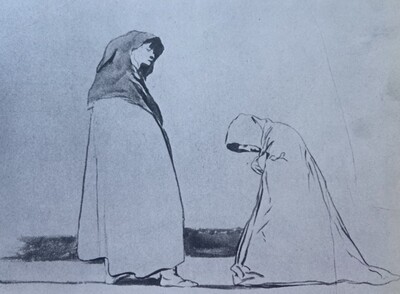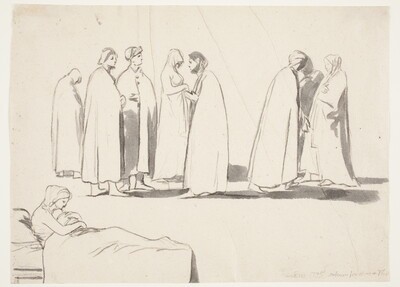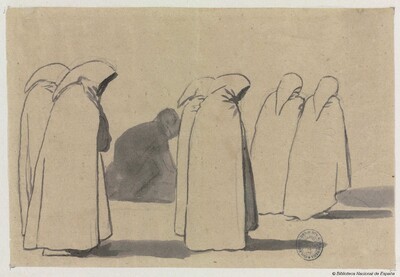- Cronología
- Ca. 1795
- Ubicación
- Biblioteca Nacional, Madrid, España, Madrid, Spain
- Dimensiones
- 158 x 260 mm
- Técnica y soporte
- Reconocimiento de la autoría de Goya
- Documented work
- Titular
- © Biblioteca Nacional de España
- Ficha: realización/revisión
- 18 Aug 2021 / 25 Apr 2023
- Inventario
- Inv. DIB/15/8/23
- Otros títulos:
-
Provenance stamp of the Carderera Collection (ink stamped, lower centre)
The drawing passed by inheritance in 1828 to Javier Goya, the painter´s son , and in 1854 to Mariano Goya y Goicoechea the artists grandson. It was subsequently owned by Valentín Carderera (ca. 1861). In 1867 it was acquired, along with the rest of the series and other drawings from the Carderera Collection, by the National Library of Spain.
John Flaxman (York, 1755-1826) was a english sculptor, illustrator and cartoonist. He lived for several years in Rome, where his work became increasingly inspired by the art of ancient Greece. In addition to sculptures, he produced excellent drawings, characterised by figures with pure lines, executed for editions of The Iliad, The Divine Comedy and the tragedies of Aeschylus. Goya, inspired by the Englishman's work, produced a series of six drawings that are difficult to date.
However, the one entitled Three Groups of Figures and between them a Moder in bed with her baby provides a clue to the possible dating of the series, as there is an inscription on the lower right-hand side of the paper that reads January 1795, most likely Goya's autograph. It is known that Flaxman's drawings to illustrate Dante's Divine Comedy were engraved in Rome by Piroli, who made a short initial print that was already finished in July 1793, and it can be affirmed that Goya was aware of Flaxman's work shortly after it was published, judging by the date on his drawing, which would correspond to its execution. If Goya had known about the second edition of the engravings, his drawings would have to be dated from 1802.
All the drawings in this series were executed on the same type of thin, beige laid paper of similar dimensions.
According to Gassier, in this drawing Goya copied the figures that appear in different engravings by Flaxman and which illustrate Dante's Inferno, confirming that the Aragonese artist did not intend to compose a coherent scene, but rather a kind of study of new forms related to the purification of lines and a rigorous stylisation of the human silhouette.
-
Madrid1922cat. 189 B
-
Grabados y dibujos de Goya en la Biblioteca NacionalBiblioteca NacionalMadrid1946catalogue Elena Páez Ríoscat. 177
-
Goya. Gemälde Zeichnungen. Graphik. TapisserienKunsthalle BaselBasle1953from January 23th to April 12th 1953
-
Goya en la Biblioteca Nacional. Exposición de grabados y dibujos en el sesquicentenario de su muerteBiblioteca NacionalMadrid1978May - June 1978cat. 168
-
Vie et ouvre de Francisco de GoyaParísOffice du livre1970p. 195, cat. 760
-
LondonThe Burlington Magazine Foundation1971pp. 508-512
-
Dibujos de Goya, 2 volsBarcelonaNoguer1975p. 513, cat. 340
-
MadridMinisterio de Cultura1978p. 47, cat. 168
-
http://catalogo.bne.esMadridBiblioteca Nacional18-03-2011





